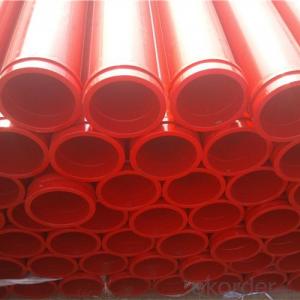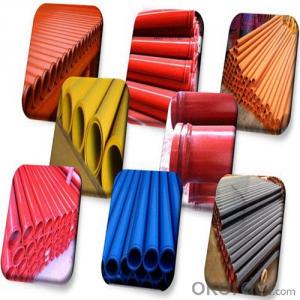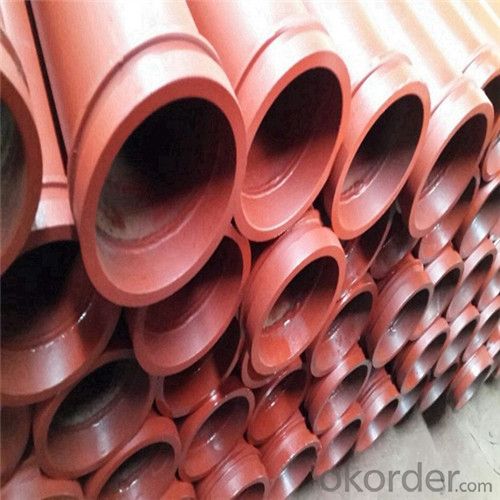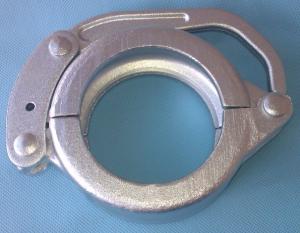3M 20# Steel Delivery Pipe for Concrete Pump
- Loading Port:
- Tianjin
- Payment Terms:
- TT or LC
- Min Order Qty:
- 50 pc
- Supply Capability:
- 5000 pc/month
OKorder Service Pledge
OKorder Financial Service
You Might Also Like
3M 20# Steel Delivery Pipe for Concrete Pump
1. Structure of 3M 20# Steel Delivery Pipe for Concrete Pump:
St52 Weld Pipe: Main use for Trailer-mounted pump, thickness has 4.0mm, 4.5mm, 5mm. Compare with for Truck-mounted pump. Weld pipe has cheaper price, so it is popular in Saudi, Pakistan, India, etc. Unit Price is about 30USD-33USD.
St52 Seamless Pipe: Now More People like use this kind for Truck Pump and Trailer Pump because of the quality is better and it is seamless kind, so this kind pipe is most popular in Middle East.
2. Main Features of 3M 20# Steel Delivery Pipe for Concrete Pump:
• In case of quality problem the company provide free replacement.
• Provide technical support for free.
• Provide consumers with regular visits
• Ensure the supply of ancillary parts
• Our company passed the ISO9000 certification, the product through 3C certification.
3. 3M 20# Steel Delivery Pipe for Concrete Pump Images
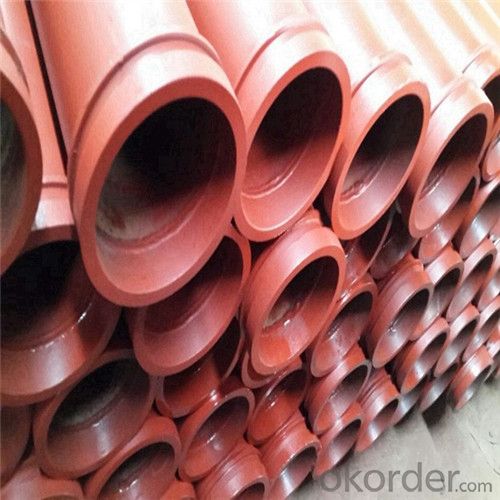


4. 3M 20# Steel Delivery Pipe for Concrete Pump Specification


Production Process

5. FAQ
We have organized several common questions for our clients, may help you sincerely:
①Is your products exported a lot?
We have exported to many, many countries. Every year we ship more than 30 containers of these spare parts. Our main market is in Middle-east, Asia & Africa.
②How to guarantee the quality of the products?
We have established the international advanced quality management system,every link from raw material to final product we have strict quality test;We resolutely put an end to unqualified products flowing into the market. At the same time, we will provide necessary follow-up service assurance.
③How long can we receive the product after purchase?
In the purchase of product within three working days, we will arrange the factory delivery as soon as possible. The specific time of receiving is related to the state and position of customers. Commonly 15 working days can be served.
6. Why choose us
• We are a comprehensive manufacturing and trading company.
• Our company is one of the biggest manufacturing and trading companies in China.
• We have been specialized in producing concrete pump spare parts and specialized in producing all kinds of concrete pump parts. As Concrete Pump Pipe, Concrete Pump Elbow, Concrete Pump Rubber Hose, Concrete Pump Wear Plate, Concrete Pump S Valve, Concrete Pump Piston and so on.
• We are famous for our superior quality, competitive prices, first-class craftworks, safe package and prompt delivery.
• We have been supplying concrete pump parts for SCHWING, PUTZMEISTER, SANY, CIFA, KYOKUTO, ZOOMLION for 10 years, so we can promise you the quality and best price.
- Q: What are the potential risks of using non-standard or modified hydraulic components in concrete pump spare parts?
- There are several potential risks associated with using non-standard or modified hydraulic components in concrete pump spare parts. Firstly, these components may not have undergone the same rigorous testing and quality control as the original equipment manufacturer (OEM) parts. As a result, their performance and durability may be compromised, which can lead to potential failures or malfunctions. This, in turn, can cause accidents, injuries, or damage to the equipment or surrounding structures. Secondly, the use of non-standard or modified components may void the warranty of the concrete pump and its spare parts. Typically, manufacturers offer warranties to ensure the reliability and safety of their products. However, by using non-standard components, the warranty may become null and void. Consequently, the user will be responsible for any repairs or replacements needed due to issues arising from these non-standard parts. Another risk is the potential compatibility issues that may arise when using non-standard or modified components. Hydraulic systems rely on precise engineering and compatibility between various components to function optimally. Non-standard or modified parts may not fit properly or may have different specifications, resulting in leaks, pressure imbalances, or reduced overall performance. Furthermore, the use of non-standard or modified components can impact the overall efficiency and productivity of the concrete pump. OEM parts are specifically designed to work seamlessly with the rest of the system, ensuring smooth operation and maximum output. However, by using non-standard parts, the performance of the pump may be compromised, leading to increased downtime, decreased productivity, and higher maintenance costs. Lastly, the use of non-standard or modified components can also have legal and regulatory implications. Certain jurisdictions may have regulations or standards in place that require the use of OEM or certified parts for specific equipment, including concrete pumps. Failure to comply with these regulations can result in fines, penalties, or legal liabilities in the event of accidents or failures. In conclusion, the potential risks associated with using non-standard or modified hydraulic components in concrete pump spare parts include compromised performance and durability, warranty voidance, compatibility issues, reduced efficiency, and legal and regulatory implications. It is always advisable to use OEM or certified spare parts to ensure the safety, reliability, and optimal performance of the equipment.
- Q: Are there any specific guidelines for the selection and installation of hydraulic components in concrete pump spare parts?
- Yes, there are specific guidelines for the selection and installation of hydraulic components in concrete pump spare parts. When choosing hydraulic components for concrete pump spare parts, it is important to consider factors such as the maximum operating pressure, flow rate, and compatibility with the existing hydraulic system. Firstly, it is crucial to ensure that the selected hydraulic components can handle the maximum operating pressure of the concrete pump. This includes components such as hydraulic cylinders, valves, and pumps. Choosing components with a higher pressure rating than the concrete pump's operating pressure can help ensure their durability and longevity. Secondly, the flow rate of the hydraulic components should match the requirements of the concrete pump system. Components such as hydraulic pumps and valves must be able to provide sufficient flow to operate the concrete pump effectively. It is important to consider factors such as the size of the concrete pump, the desired output capacity, and the specific pumping requirements. Moreover, compatibility with the existing hydraulic system is crucial for the smooth operation of the concrete pump. Hydraulic components should be selected based on their compatibility with the existing system in terms of fittings, connections, and overall design. It is advisable to consult the manufacturer's guidelines or seek professional advice when selecting and installing hydraulic components in concrete pump spare parts. Furthermore, proper installation is essential to ensure the optimal performance and safety of hydraulic components in concrete pump spare parts. It is recommended to follow the manufacturer's installation instructions and guidelines. The installation process should include proper alignment, secure mounting, and appropriate sealing of the components to prevent any leaks or failures. In conclusion, there are specific guidelines for the selection and installation of hydraulic components in concrete pump spare parts. Considering factors such as maximum operating pressure, flow rate, compatibility, and following proper installation procedures can help ensure the efficient and safe operation of the concrete pump system.
- Q: How can a malfunctioning remote control affect the pumping operation?
- A malfunctioning remote control can significantly impact the pumping operation in various ways. Firstly, a remote control is used to operate the pump remotely, allowing operators to control the pump's speed, direction, and other important settings from a distance. If the remote control malfunctions, operators may lose the ability to control the pump effectively, leading to delays or inefficiencies in the pumping operation. Secondly, a malfunctioning remote control may result in inconsistent or erratic commands being sent to the pump. This can lead to unstable pump performance, potentially causing fluctuations in flow rates, pressure, or other critical parameters. Such inconsistencies can affect the overall efficiency and effectiveness of the pumping operation. Additionally, a malfunctioning remote control can pose safety risks. For instance, if the remote control fails to transmit accurate commands, it can potentially result in the pump operating at undesirable speeds or pressures, which may lead to equipment damage or accidents. Moreover, if operators are unable to control the pump remotely during emergencies or hazardous situations, it could hinder their ability to promptly respond and mitigate risks. Furthermore, a malfunctioning remote control may also impact the monitoring and control systems associated with the pumping operation. Remote controls are often integrated with centralized monitoring systems, allowing operators to collect real-time data and receive alerts or alarms. If the remote control fails, it may disrupt the flow of critical information, making it challenging for operators to monitor the pump's performance, identify potential issues, or make informed decisions. In conclusion, a malfunctioning remote control can have detrimental effects on the pumping operation by impeding the ability to control the pump remotely, causing erratic pump performance, posing safety risks, and hindering the monitoring and control systems. Therefore, it is crucial to regularly inspect and maintain remote controls to ensure their proper functionality and minimize any potential disruptions to the pumping operation.
- Q: What is the function of a concrete pump hopper grate pin?
- The function of a concrete pump hopper grate pin is to securely hold the grate in place, preventing it from shifting or becoming dislodged during the concrete pumping process.
- Q: Can concrete pump spare parts be painted or coated for increased durability?
- Concrete pump spare parts can achieve greater durability by undergoing painting or coating. This protective measure shields them from corrosion, wear, and other types of harm. Applying a layer of paint or coating enhances their resistance against harsh environmental conditions, chemicals, and moisture. Furthermore, certain paints or coatings can provide extra advantages like heat resistance or non-stick properties, further bolstering the spare parts' durability and performance. It is crucial to utilize appropriate paints or coatings that are specifically formulated for the materials and conditions the spare parts will encounter, guaranteeing optimal adhesion and longevity.
- Q: What are the different types of concrete pump control system sensors?
- The different types of concrete pump control system sensors include pressure sensors, flow sensors, level sensors, temperature sensors, and proximity sensors.
- Q: Why would the plugging concrete pump pipe
- Pump operator in pumping construction should concentrate, always pay attention to pumping pressure meter readings, once found that the pressure gauge reading suddenly increased, should immediately anti pump 2-3 stroke, and then pump, pipe can be excluded
- Q: How can a faulty pressure gauge affect the concrete pumping process?
- A faulty pressure gauge can have significant impact on the concrete pumping process. It can lead to inaccurate measurements of the pressure within the pump, which can result in improper monitoring and control of the pumping process. This can lead to over or under pressurization, affecting the flow and consistency of the concrete being pumped. Additionally, a faulty pressure gauge may not provide reliable readings, making it difficult to detect any potential issues or abnormalities in the pumping system, which can compromise the quality and integrity of the concrete being pumped.
- Q: How often should hopper grate pins be inspected or replaced in a concrete pump?
- To maintain proper functioning and prevent potential problems, it is important to regularly inspect the hopper grate pins in a concrete pump. A suggested guideline is to inspect these pins at least once a month or after every 200 hours of operation, whichever comes first. However, the inspection frequency may vary based on the specific conditions and usage of the concrete pump. During the inspection, it is crucial to examine the hopper grate pins for any signs of wear, damage, or deformities. If any issues are discovered, they should be promptly addressed to prevent further damage and ensure the safe and efficient operation of the concrete pump. When significant signs of wear or damage are observed in the hopper grate pins, it is necessary to replace them immediately to maintain their functionality. It is important to follow the manufacturer's guidelines and recommendations for replacing these pins, as they may differ depending on the specific model and design of the concrete pump. By conducting regular inspections and replacing hopper grate pins in a timely manner, the longevity and reliability of the concrete pump can be enhanced, reducing the risk of unexpected breakdowns and ensuring optimal performance.
- Q: Can I get spare parts for concrete pump accessories like remote control systems?
- Yes, you can get spare parts for concrete pump accessories like remote control systems. Many manufacturers and suppliers of concrete pump accessories offer a range of spare parts for their products. These spare parts may include components for remote control systems such as buttons, switches, sensors, batteries, and transmitters. It is advisable to contact the manufacturer or supplier directly to inquire about the availability of spare parts for the specific model of remote control system you have. They will be able to provide you with the necessary information and assist you in obtaining the required spare parts.
Send your message to us
3M 20# Steel Delivery Pipe for Concrete Pump
- Loading Port:
- Tianjin
- Payment Terms:
- TT or LC
- Min Order Qty:
- 50 pc
- Supply Capability:
- 5000 pc/month
OKorder Service Pledge
OKorder Financial Service
Similar products
Hot products
Hot Searches
Related keywords
